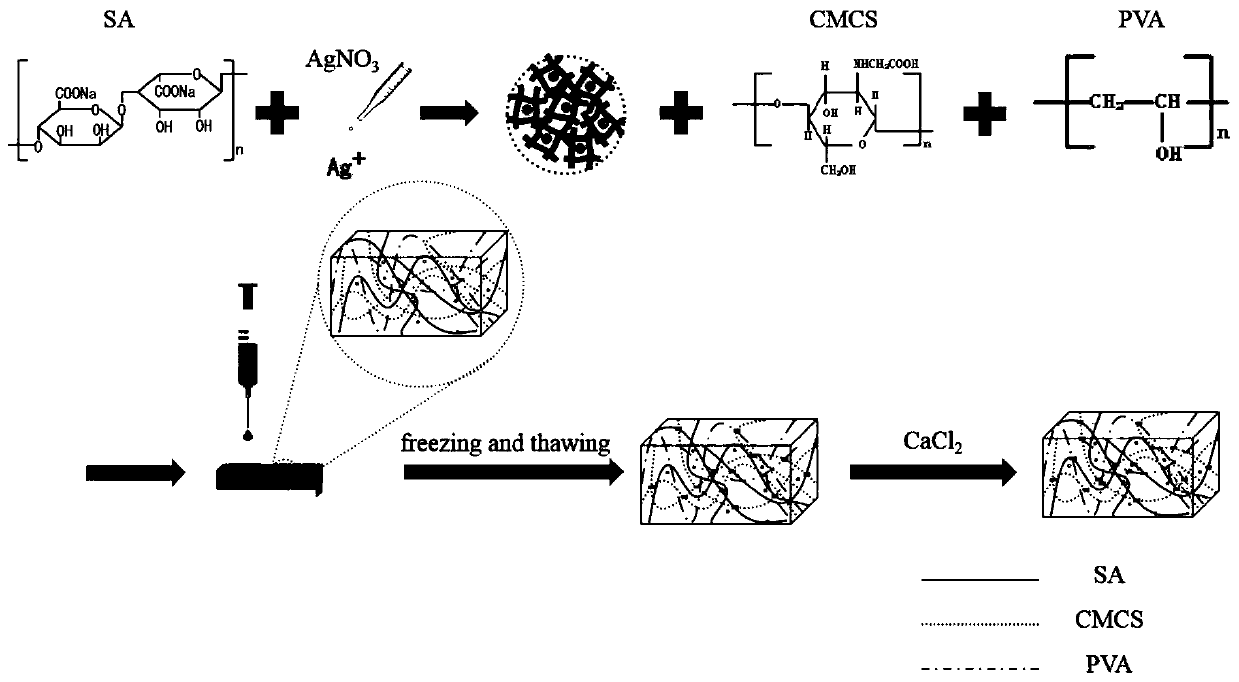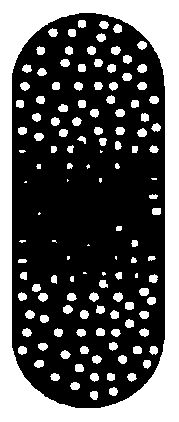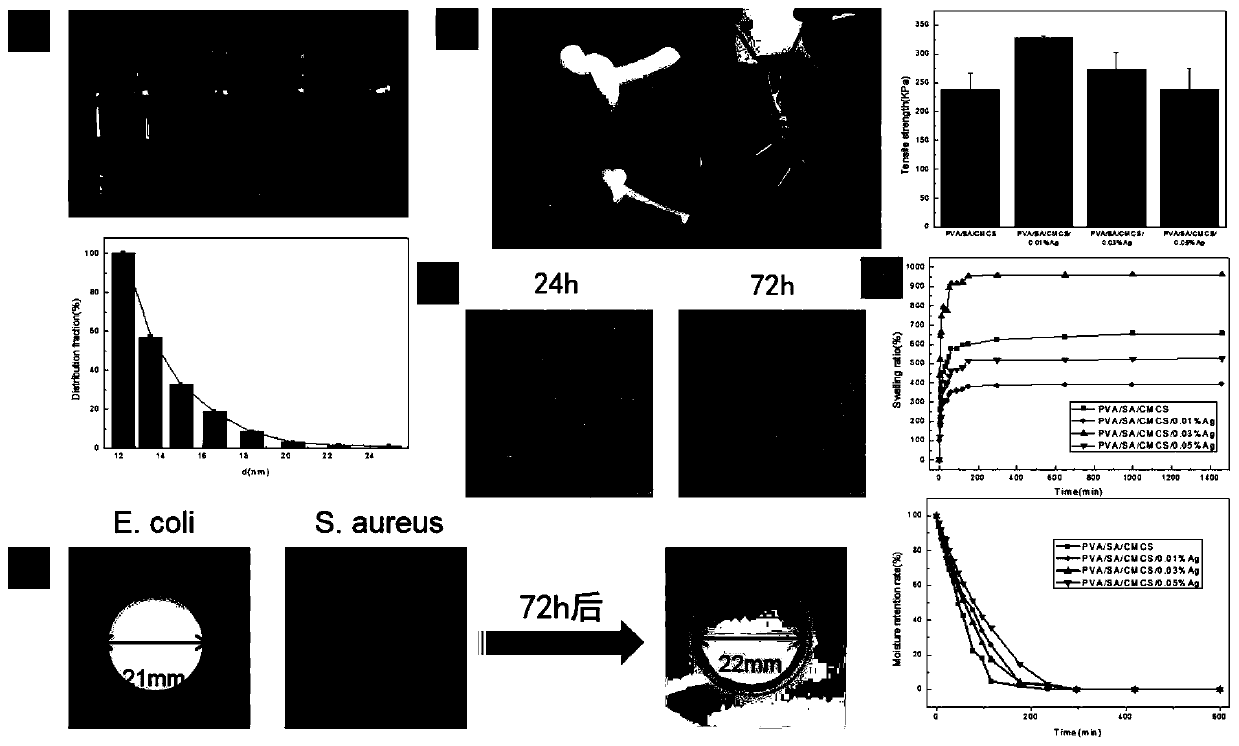3D-printed hydrogel wound dressing with long-acting antibacterial effect
A 3D printing, antibacterial technology, applied in medical science, additive processing, bandages, etc., can solve problems such as weak antibacterial properties of antibacterial hydrogels, potential safety hazards in preparation methods, and inability to meet antibacterial requirements, so as to reduce potential cells Effects of toxicity, excellent antibacterial properties, and high water absorption
- Summary
- Abstract
- Description
- Claims
- Application Information
AI Technical Summary
Problems solved by technology
Method used
Image
Examples
preparation example Construction
[0029] The invention discloses a preparation method of a 3D printed hydrogel wound dressing with long-acting antibacterial effect. Preparation materials include: raw materials for reducing nano-silver: sodium alginate, silver nitrate; raw materials for building hydrogel: polyvinyl alcohol, carboxymethyl chitosan, sodium alginate, deionized water; raw materials for cross-linked hydrogel : Calcium chloride.
[0030] Such as figure 1 As shown, the preparation process:
[0031] (1) prepare nano-silver-sodium alginate;
[0032] (2) prepare polyvinyl alcohol / carboxymethyl chitosan / sodium alginate solution;
[0033] (3) Prepare the solution to be printed;
[0034] (4) 3D printing hydrogel on non-woven fabric;
[0035] (5) The sample prepared in step 4 was cross-linked (freezing-thawing and soaking in calcium chloride); thereby obtaining a silver-loaded polyvinyl alcohol / carboxymethyl chitosan / sodium alginate hydrogel wound dressing.
[0036] The prepared hydrogel wound dressing...
Embodiment 1
[0039] 1) Reduction of nano-silver: dissolving sodium alginate in deionized water, heating in a water bath at 50° C. and fully stirring to obtain a sodium alginate solution with a mass fraction of 0.2%; preparing a silver nitrate solution with a mass fraction of 1%. The silver nitrate solution was added dropwise to the sodium alginate solution at a mass ratio of 1:100, reacted at 90°C in the dark for more than 10 hours, and stirred vigorously to obtain a yellow nano-silver-sodium alginate solution.
[0040] 2) Preparation of polyvinyl alcohol / carboxymethyl chitosan / sodium alginate solution: Dissolve polyvinyl alcohol in deionized water, fully swell, heat and stir in a water bath at 95° C., and fully dissolve. Add carboxymethyl chitosan and sodium alginate, and stir evenly at 50° C. to obtain a polyvinyl alcohol / carboxymethyl chitosan / sodium alginate solution.
[0041] 3) Preparation of the solution to be printed: Mix the nano-silver-sodium alginate solution and the polyvinyl a...
Embodiment 2
[0045] 1) Reduction of nano-silver: dissolving sodium alginate in deionized water, heating in a water bath at 50° C. and fully stirring to obtain a sodium alginate solution with a mass fraction of 0.2%; preparing a silver nitrate solution with a mass fraction of 1%. The silver nitrate solution was added dropwise to the sodium alginate solution at a mass ratio of 3:100, reacted at 90°C in the dark for more than 10 hours, and stirred vigorously to obtain a yellow nano-silver-sodium alginate solution.
[0046] 2) Preparation of polyvinyl alcohol / carboxymethyl chitosan / sodium alginate solution: Dissolve polyvinyl alcohol in deionized water, fully swell, heat and stir in a water bath at 95° C., and fully dissolve. Add carboxymethyl chitosan and sodium alginate, and stir evenly at 50° C. to obtain a polyvinyl alcohol / carboxymethyl chitosan / sodium alginate solution.
[0047] 3) Preparation of the solution to be printed: Mix the nano-silver-sodium alginate solution and the polyvinyl a...
PUM
 Login to View More
Login to View More Abstract
Description
Claims
Application Information
 Login to View More
Login to View More - R&D
- Intellectual Property
- Life Sciences
- Materials
- Tech Scout
- Unparalleled Data Quality
- Higher Quality Content
- 60% Fewer Hallucinations
Browse by: Latest US Patents, China's latest patents, Technical Efficacy Thesaurus, Application Domain, Technology Topic, Popular Technical Reports.
© 2025 PatSnap. All rights reserved.Legal|Privacy policy|Modern Slavery Act Transparency Statement|Sitemap|About US| Contact US: help@patsnap.com



